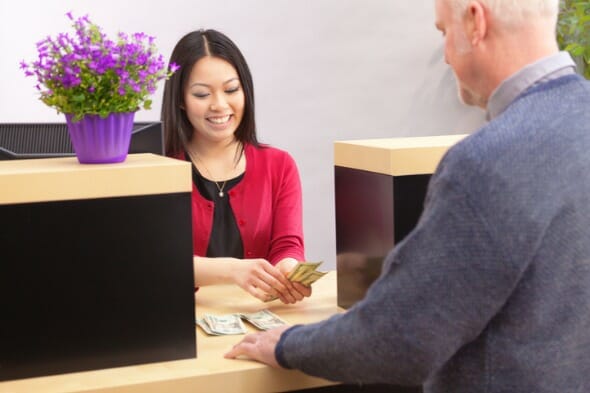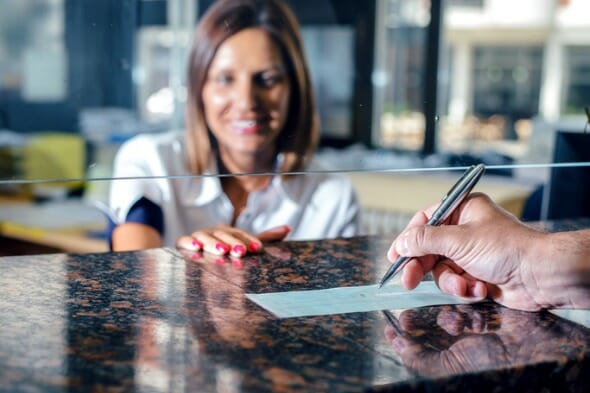At some point, you may end up receiving money in the form of a check. This could be your paycheck, your tax refund or a personal check from a friend. Unlike cash, you can’t turn around and spend the check on a purchase immediately. However, no matter where the check comes from, cashing it is an easy process. This gives you more immediate access to cash than depositing the check.
A financial advisor can explain safe and cost-effective options for cashing checks and help integrate that process into a broader money management plan.
Types of Checks
There are two major types of checks: business checks and personal checks. Business checks are issued by businesses, like your employment paycheck or payments from your insurance company. Personal checks are written by an individual, like a check your grandmother gives you for your birthday. Generally, it is much easier to find locations that will cash business checks than will cash personal checks. Personal checks run the risk of being written from an account without enough money in it. This results in the check bouncing, meaning you cannot cash it.
Other common types of checks include cashier’s checks. These checks contain guaranteed funds linked to a bank’s own account. Other guaranteed options include certified checks.
How to Cash a Check
You can cash your check in a number of places. But before we get into that, it’s important to know what you’ll need first. For starters, you will need to provide photo ID when you go to cash a check. This ensures that the check is definitely meant for you. Then, no matter where you cash your check, you must endorse it. On the back, you’ll see a line with an “X.” This is the endorsement line, where you sign the check to show you accept it. For safety, don’t sign the check until you are ready to deposit or cash it. It helps even more if you sign it in front of your bank teller or whoever will cash it for you.
You also have the option of depositing the check into your checking or savings account. In this case, you would still sign the back of your check, but you will also write in your account number and “For deposit only” above your signature. You can then either immediately withdraw some funds or request that amount with your teller. You can do this by also filling out a deposit slip, where you provide your account number, the check number (typically found in one of the top corners of the check) and the amount of the check.
If you would like to receive cash back immediately from the check, write the amount you want to receive on the deposit slip as well, in the “debits” or “less cash” section, and subtract it from the amount of the check for the total deposit. Note that you may not be able to receive all of the funds from the check that same day, as the bank may have to wait for the check to clear the checkwriter’s account.
You can cash your check in a number of places, but there are a number of steps you need to be aware of first.
- For starters, you will need to provide a photo ID when you go to cash a check. This ensures that the check is definitely meant for you.
- Next, endorse the check. On the back, you’ll see a line with an “X.” This is the endorsement line, where you sign the check to show you accept it. For safety, don’t sign the check until you are ready to deposit or cash it.
- Then, decide where it’s going to get deposited. You can use your checking or savings account. For savings deposits, sign the back of your check but add your account number and “For deposit only” above your signature.
- If you need don’t want to leave the money in your account you can withdraw some funds or request that amount with your teller by also filling out a deposit slip. You will need to provide your account number, the check number (typically found in one of the top corners of the check) and the amount of the check.
If you would like to receive cash back immediately from the check, write the amount you want to receive on the deposit slip as well, in the “debits” or “less cash” section. Then, subtract it from the amount of the check for the total deposit. Note that you may not be able to receive all of the funds from the check that same day, as the bank may have to wait for the check to clear.
Where to Cash a Check

The simplest place to cash a check is at the bank. You can cash (or deposit) the check at your own bank. But you can also cash it at the bank that issued the check, too.
To get cash in hand instead of depositing a check you need to go to the bank in person, with your ID. The benefit of an in-person transaction is that you can receive a larger amount of money than depositing the check with your smartphone or at an ATM. If the check bounces, however, not only will you not get the money, but your bank may charge you a returned check fee.
If you go to the issuing bank to cash the check, you can usually receive the entire amount. This is because the bank has more immediate access to the account being drawn from for the funds. You may face a fee if you don’t have an account, like a checking account, with this bank. Also, if the account in question does not have sufficient funds to cover the check, the issuing bank does not have an obligation to give you the entire amount.
If you need to cash a check but don’t want to use a bank there are several options to consider. Most banks offer mobile check cashing through their respective apps. The process is the same. You endorse the check, usually with a “for electronic deposit only” write-in, then photograph both sides. After you submit the photos and any other information requested by the bank you can expect the funds in 1-2 business days. Other apps, like Walmart’s MoneyCArd app or services like Venmo and PayPal, also offer electronic check cashing. There also come with more fees and longer wait times than banking apps, however.
Large retail chains can also offer check cashing services. These can be convenient but do come with some restrictions. Many stores won’t cash personal checks, only more official payments issued by banks, the government, a payroll company, etc. There is usually a limit between $1,000-$5,000 depending on the retailer and their respective membership programs. And you can expect to encounter fees around $3-$5 per transaction.
You may also consider using a prepaid debit card service through an electronic bank. These companies don’t have traditional brick-and-mortar locations, but offer the convenience of electronic banking by issuing debit cards you can load with your own cash. Like retail checking, you will face some restrictions on the type of check, transaction amount, and state and local regulations. For example, Green Dot requires you to cash the check at Walmart before adding funds to your card.
As a last resort you may also use a check-cashing store. There are thousands of these stores in the U.S., but they charge the highest fees of any of these options. You also run the risk of being talked into taking a payday loan, where the company will give you an advance on your paycheck in exchange for very high interest rates.
How to Cash a Check Without a Bank Account
Cashing a check at the issuing bank is probably your best bet if you don’t have a bank account. Don’t forget that you’ll need photo ID and that you may have to pay a fee, either a flat rate (like $5) or a percent of the check amount (like 1%). It may be a good idea to open a checking account if you can, especially if you’ll be receiving more checks in the future. Luckily, there are a number of free checking accounts that make it easy to open and own one.
Major retailers can also cash checks, including stores like Walmart, 7-Eleven, Kmart and certain supermarkets. A drawback here is that many stores may only cash business and payroll checks, not personal checks. Either way, there will still be a fee, although it’s typically minimal. For example, Kmart charges up to $1 while Walmart charges $3 on checks of $1,000 or less and $6 for checks larger than that. You likely won’t face a check cashing fee over $10.
There are stores that specialize in check cashing. These stores will cash nearly any check you bring them, but they charge hefty fees for this service. Some fees can be up to 10%. For large checks, these fees can get costly. This means you can end up paying a $100 fee for a $1,000 check!
Finally, you can choose to deposit the check to a prepaid card account. Prepaid cards are linked to pre-funded debit accounts and don’t require a bank account to use. If your prepaid card is linked to a bank, you can use the bank’s ATM to deposit your check into your account. Some prepaid cards also offer apps that allow you to deposit the check virtually with a picture.
Bottom Line

If you have a check you need to cash, you have many options to do so. The best way is to cash or deposit the check with your bank. That allows you to avoid hefty fees and gives you have access to all or some of the money more immediately. Without a bank account, you’ll likely have to pay a fee to cash a check at the issuing bank, major retailers, check-cashing stores or into a prepaid debit card account. Wherever you cash your check, don’t forget to bring your photo ID and to endorse the check right before you cash it.
Tips for Responsible Money Management
- Unfortunately, money scams are all too common nowadays. If you’re receiving a check as payment, especially from someone you don’t know or necessarily trust, be wary of their payment. You can always call the issuing back to ensure that the check is real and the check writer has enough funds in their account. This will prevent the check from bouncing after you try to cash it.
- If you don’t have a bank account, you’re not alone. However, it can really help your finances to have a checking and/or savings account. This makes it easier to keep track of your money and keep it all safe. If you’re worried about the fees often associated with checking and savings accounts, you still have options. Some of the best checking accounts don’t charge monthly fees or even require a minimum deposit. You can also compare savings accounts from different banks in your area to see which ones offer the best deals.
- If you need further money management advice or you’re ready to start investing, it may be time to hire a financial advisor. Finding a financial advisor doesn’t have to be hard. SmartAsset’s free tool matches you with vetted financial advisors who serve your area, and you can have a free introductory call with your advisor matches to decide which one you feel is right for you. If you’re ready to find an advisor who can help you achieve your financial goals, get started now.
Photo credit: ©iStock.com/dardespot, ©iStock.com/YinYang, ©iStock.com/PhotoInc
